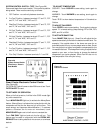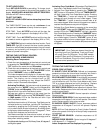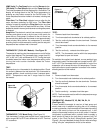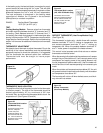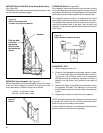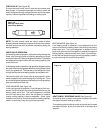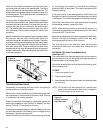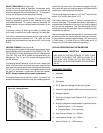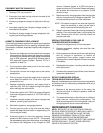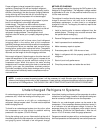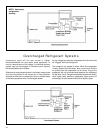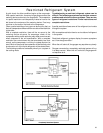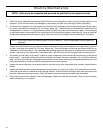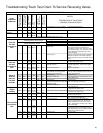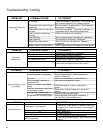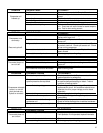
30
HERMETIC COMPONENT REPLACEMENT
The following procedure applies when replacing components
in the sealed refrigeration circuit or repairing refrigerant leaks.
(Compressor, condenser, evaporator, capillary tube, refrigerant
leaks, etc.)
1. Recover the refrigerant from the system at the process
tube located on the high side of the system by installing
a line tap on the process tube. Apply gauge from process
tube to EPA approved gauges from process tube to
EPA approved recovery system. Recover CFC's in
system to at least 5%.
2. Cut the process tube below pinch off on the suction
side of the compressor.
3. Connect the line from the nitrogen tank to the suction
process tube.
4. Drift dry nitrogen through the system and un-solder the
more distant connection first. (Filter drier, high side
process tube, etc.)
5. Replace inoperative component, and always install a
new filter drier. Drift dry nitrogen through the system
when making these connections.
6. Pressurize system to 30 PSIG with proper refrigerant
and boost refrigerant pressure to 150 PSIG with dry
nitrogen.
7. Leak test complete system with electric halogen leak
detector, correcting any leaks found.
8. Reduce the system to zero gauge pressure.
9. Connect vacuum pump to high side and low side of
system with deep vacuum hoses, or copper tubing. (Do
not use regular hoses.)
10. Evacuate system to maximum absolute holding
pressure of 200 microns or less. NOTE: This process
can be speeded up by use of heat lamps, or by breaking
the vacuum with refrigerant or dry nitrogen at 5,000
EQUIPMENT MUST BE CAPABLE OF:
1. Recovery CFC's as low as 5%.
2. Evacuation from both the high side and low side of the
system simultaneously.
3. Introducing refrigerant charge into high side of the sys-
tem.
4. Accurately weighing the refrigerant charge actually in-
troduced into the system.
5. Facilities for flowing nitrogen through refrigeration tub-
ing during all brazing processes.
microns. Pressure system to 5 PSIG and leave in
system a minimum of 10 minutes. Release refrigerant,
and proceed with evacuation of a pressure of 200
microns or less.
11. Break vacuum by charging system from the high side
with the correct amount of refrigerant specified. This
will prevent boiling the oil out of the crankcase.
NOTE: If the entire charge will not enter the high side,
allow the remainder to enter the low side in
small increments while operating the unit.
12. Restart unit several times after allowing pressures to
stabilize. Pinch off process tubes, cut and solder the
ends. Remove pinch off tool, and leak check the
process tube ends.
SPECIAL PROCEDURE IN THE CASE OF
COMPRESSOR MOTOR BURNOUT
1. Recover all refrigerant and oil from the system.
2. Remove compressor, capillary tube and filter drier
from the system.
3. Flush evaporator condenser and all connecting tubing
with dry nitrogen or equivalent, to remove all
contamination from system. Inspect suction and
discharge line for carbon deposits. Remove and clean
if necessary.
4. Reassemble the system, including new drier strainer
and capillary tube.
5. Proceed with processing as outlined under hermetic
component replacement.
ROTARY COMPRESSOR SPECIAL
TROUBLESHOOTING AND SERVICE
Basically, troubleshooting and servicing rotary compressors
is the same as on the reciprocating compressor with only a
few exceptions.
1. Because of the spinning motion of the rotary, the
mounts are critical. If vibration is present, check the
mounts carefully.
2. The electrical terminals on the rotary are in a different
order than the reciprocating compressors. The
terminal markings are on the cover gasket. Use your
wiring diagram to insure correct connections.
REFRIGERANT CHARGING
NOTE: BECAUSE THE RAC SYSTEM IS A SEALED
SYSTEM, SERVICE PROCESS TUBES WILL HAVE TO
BE INSTALLED. FIRST INSTALL A LINE TAP AND
REMOVE REFRIGERANT FROM SYSTEM. MAKE
NECESSARY SEALED SYSTEM REPAIRS AND
VACUUM SYSTEM. CRIMP PROCESS TUBE LINE AND
SOLDER END SHUT. DO NOT LEAVE A SERVICE
VALVE IN THE SEALED SYSTEM.



